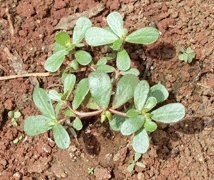By Pat Hitchcock, U. C. Master Gardener of Napa County
This winter seems to be a promising one; it's raining regularly. But along with the filling reservoirs and green hills come a multitude of weeds.
University of California Agriculture and Natural Resources publishes “Weed Pest Identification and Monitoring Cards” (Publication 3541) that identify nearly 50 different broadleaf and grassy weeds common in California. The cards have pictures of the plants at different stages of growth, as well as information on how they spread, where they grow and how to control them. Alas, most of them grow well on my property.
Weeds can't grow without water. Once the rains begin, they sprout from seeds or emerge from their dry-season dormancy. I was curious as to where they originated and why so many thrive here, so I began researching. It is daunting to discover that the weeds in my backyard come from all over the world.
Take dandelions (Taraxacum officinale). There are native American versions, but the more widespread dandelion was imported from Europe as an edible and medicinal plant. Today, most of us consider it a weed, although some people still enjoy it as a cooked green or salad.
Another common edible weed is purslane (Portulaca oleracea), a succulent summer annual with small yellow flowers. Purslane has been eaten throughout Europe, Asia and the Middle East since prehistoric times, but when it arrived in the New World is unclear. It makes a lemony addition to salads.
Several annual grasses thrive in Napa Valley winters, including Italian ryegrass (Lolum multiflorum), wild oat (Avena fatua) and ripgut brome (Bromus diandrus). These appear to have originated in the temperate regions of Europe but are widespread in our grasslands, parks and farmland. Besides taking over cultivated soil and crowding out garden plants, some have troublesome seeds that catch on pet fur or clothing and work their way into flesh. Pet owners know what misery these so-called “foxtails” can cause dogs and cats.
One of the most persistent weeds in my garden is field bindweed (Convolvulus arvensis). This perennial plant originated in Europe and Asia and most likely arrived with crop seeds in the 1700s. It quickly became invasive. Roots can grow as deep as 10 feet and prefer moist, fertile soil. That pretty much describes my vegetable beds; no wonder I am constantly pulling and digging this plant out.
Redstem fillaree (Erodium cicutarium) is a plant I loved as a child. I liked to pick off the drying seed head and watch it coil when separated from its flower. Now, as a gardener, I find its ability to stick to clothing, especially socks, truly annoying. Native to the Mediterranean basin, this plant is edible, but the leaves are best eaten young.
Mustard (Sinapsis arvensis) is another weed originating in the Mediterranean basin. Legend has it that the Spanish padres deliberately sowed mustard along El Camino Real to mark the way. More likely, this plant arrived in North America accidentally like so many others.
Wild radish (Raphanus raphanistrum) is related to mustard.Native to Asia, it has spread all over the world. According to the weed I.D. cards, it is similar to Raphanus sativus, the common radish, and hybridizes easily with it. Both have four-petal flowers that may be white, yellow or pale purplish-pink. They bloom in early spring and continue as late as July, producing a lot of seeds over several months. Seeds can remain viable in the soil for 30 years, so preventing seed production is one key to controlling the weed.
Redroot pigweed (Amaranthus retroflexus) is another apparently edible weed in our region. It is native to the tropical Americas but has naturalized all over the world. An annual plant, it spreads by seed that can live up to 40 years.
Prickly lettuce (Lactuca serriola) is an unattractive plant with prickly leaves and stems and bitter sap. Who would guess that it is the nearest wild relative of our common garden lettuces? It appears to have originated in Europe, Asia and North Africa, and ancient Greeks and Egyptians used it.
Some say that a weed is any plant in the wrong place. The weeds I researched thrive all over the world due to their ability to out-compete other plants for water, sunlight and nutrients. Controlling weeds is important both in cultivated gardens like my vegetable patch and in natural areas where they can crowd out native plants.
As the I.D. cards suggest, the best way to control most weeds is by manually removing them before they can bloom and produce seed. Another word for that is weeding. Winter is a good time to get out there and enjoy, I mean control, your weeds.
Workshop: U. C. Master Gardeners of Napa County will hold a workshop on “Fruit Tree Pruning and Grafting” on Saturday, January 21, from 9 a.m. to 2 p.m., at the University of California Cooperative Extension office, 1710 Soscol Avenue, Napa. The dormant season is the best time to prune your deciduous fruit trees to increase vigor. Join the Master Gardeners fruit-tree team for this workshop showing techniques to develop healthy and productive fruit trees. A local expert grafter will give a grafting demonstration. The afternoon field trip offers home gardeners the opportunity for a hands-on experience. Dress for seasonal outdoor weather and bring your pruners. Online registration (credit card only); Mail-in registration (check only or drop off cash payment)
Master Gardeners are volunteers who help the University of California reach the gardening public with home gardening information. U. C. Master Gardeners of Napa County ( http://ucanr.edu/ucmgnapa/) are available to answer gardening questions in person or by phone, Monday, Wednesday and Friday, 9 a.m. to Noon, at the U. C. Cooperative Extension office, 1710 Soscol Avenue, Suite 4, Napa, 707-253-4143, or from outside City of Napa toll-free at 877-279-3065. Or e-mail your garden questions by following the guidelines on our web site. Click on Napa, then on Have Garden Questions? Find us on Facebook under UC Master Gardeners of Napa County.
